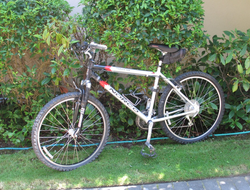Get Physically Active and Get Fit
Published: March 13, 2020
Physical fitness is within your reach.
A minimum amount of physical activity and/or exercise can help you develop physical fitness and achieve a healthy body.
Physical fitness describes a body that has strong muscles, flexible joints, an endurance capacity to take on the physical challenges of everyday life and have energy in reserve.
You don't need to be doing vigorous, structured and planned activities (exercise) to achieve a level of physical fitness that will enhance the quality of your life and provide you with a variety of health benefits.
Physical fitness can be fitted into your daily routine.
But what can physical fitness do for you?
Physical inactivity or being sedentary leads to weak muscles, fatigue, feeling unwell, and provides an environment for the development of chronic diseases such as heart disease, obesity, and diabetes type 2, and may shorten your lifespan.
Developing physical fitness, by being physically active throughout the day, has positive health benefits such as:
- improved sleep
- good heart and lung function: cardiovascular fitness
- decreased risk of heart disease through lower cholesterol levels and lower blood pressure
- improved body composition and bone density
- improved muscular strength and endurance
- improved flexibility
- may protect against colon and breast cancers
- enhances your immune system to protect against colds and flu
- reduces the risk of type 2 diabetes, and gall bladder disease
- improves self image, and lowers the incidence and severity of depression and anxiety
- may lengthen your lifespan as well as improving your quality of life in later years.
Recent studies indicate that people who are regularly physically active show less "aging" damage to their genetic material.
Aerobic physical activity may benefit older women at high risk for cognitive decline.
With all these wonderful benefits of physical fitness who would want to turn up a chance to get fit?
Every bit of movement counts. Yes, you've heard it all before, take the stairs, walk to the stores, and walk your dog, and so on. But is this enough?
It depends on what your goals are. You need to do a minimum of 150 minutes of physical activity a week to get some fitness benefits from physical activity.
Spread your physical activity throughout the week and it can be broken up into small amounts.
Aim for a minimum of 30 minutes a day of moderate physical activity.
If weight loss is your goal then aim for more than 60 minutes of low to moderate intensity physical activity as well as making healthy food choices. You can space your physical activity throughout the day.
If you want to aim for a higher physical fitness level you will need to increase the intensity and/or duration of your activities.
Improving your cardiovascular fitness will require increasing, for example, your walking pace and/or adding hills to your walking activity.
Increasing muscle strength will require that you either lift heavier objects or do more repetitions, or both. Mixing low to moderate and higher intensity activities will provide you with variety.
No excuses, let's get moving.
Instead of watching your dog walk or your kids play, join in and "really" walk your dog or play with your kids. Have fun and get fit.
Follow the links embedded in the article to learn more about physical activity and health, and out to fit physical activity into your life.
References
1.
Whitney, E. & Rady Rolfes, S. (2005). Understanding Nutrition. Belmont, CA: Thomson Wadsworth
2.
CSEP (2003).The Canadian Physical Activity, Fitness & Appraisal. Health Canada
3.
Cherkas et al (2008). The association between physical activity in leisure time and leukocyte telomere length. Archive of Internal Medicine 168(2), 152-157
4.
Rampersaud et al. (2008). Physical activity and the association of a common FTO gene variants with body mass index and obesity. Archives of Internal Medicine. 168, 1791-1797
5.
Baker et al. (2010). Effects of aerobic exercise on mild cognitive impairment. Archives of Neurology, 67 (1), 71-79


